Intel Core i7-10700 vs Core i7-10700K Review: Is 65W Comet Lake an Option?
by Dr. Ian Cutress on January 21, 2021 10:30 AM EST- Posted in
- CPUs
- Intel
- Core i7
- Z490
- 10th Gen Core
- Comet Lake
- i7-10700K
- i7-10700
Gaming Tests: Red Dead Redemption 2
It’s great to have another Rockstar benchmark in the mix, and the launch of Red Dead Redemption 2 (RDR2) on the PC gives us a chance to do that. Building on the success of the original RDR, the second incarnation came to Steam in December 2019 having been released on consoles first. The PC version takes the open-world cowboy genre into the start of the modern age, with a wide array of impressive graphics and features that are eerily close to reality.
For RDR2, Rockstar kept the same benchmark philosophy as with Grand Theft Auto V, with the benchmark consisting of several cut scenes with different weather and lighting effects, with a final scene focusing on an on-rails environment, only this time with mugging a shop leading to a shootout on horseback before riding over a bridge into the great unknown. Luckily most of the command line options from GTA V are present here, and the game also supports resolution scaling. We have the following tests:
- 384p Minimum, 1440p Minimum, 8K Minimum, 1080p Max
For that 8K setting, I originally thought I had the settings file at 4K and 1.0x scaling, but it was actually set at 2.0x giving that 8K. For the sake of it, I decided to keep the 8K settings.
For our results, we run through each resolution and setting configuration for a minimum of 10 minutes, before averaging and parsing the frame time data.
| AnandTech | Low Resolution Low Quality |
Medium Resolution Low Quality |
High Resolution Low Quality |
Medium Resolution Max Quality |
| Average FPS | 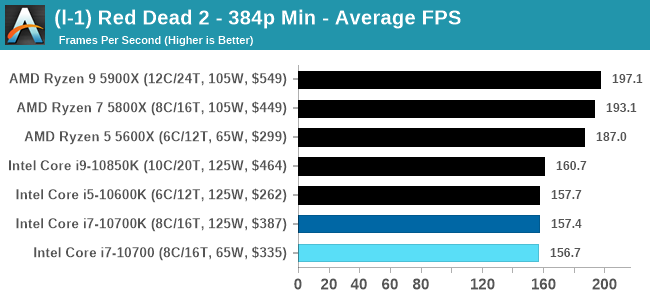 |
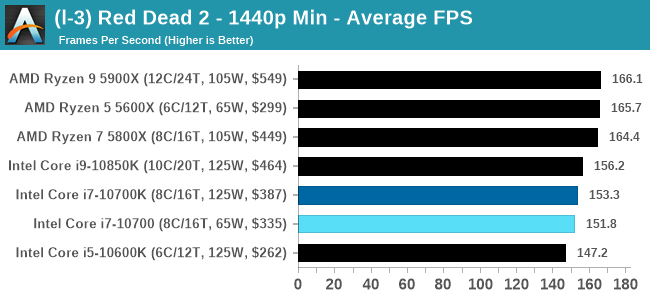 |
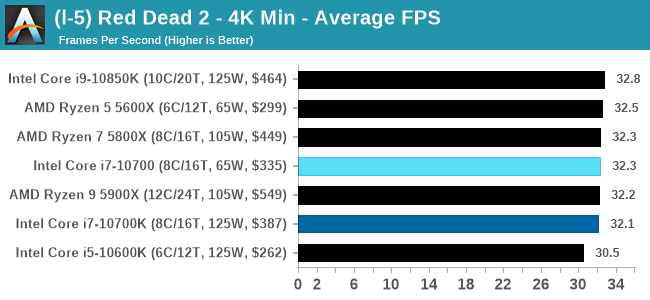 |
 |
| 95th Percentile | 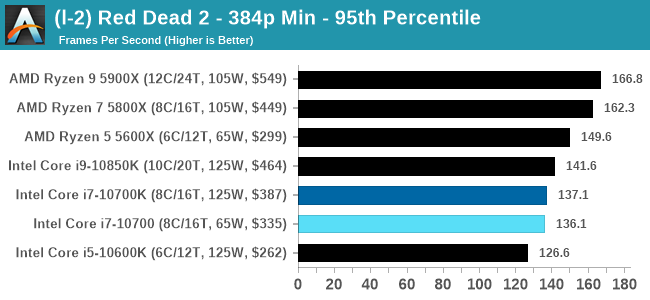 |
 |
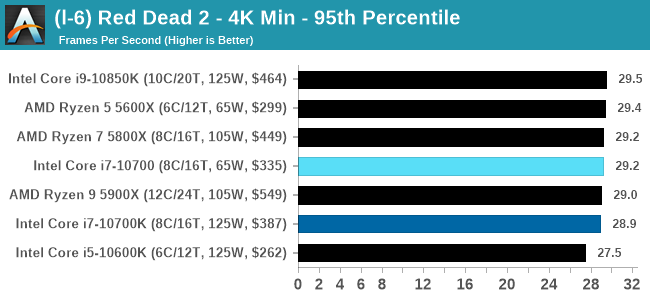 |
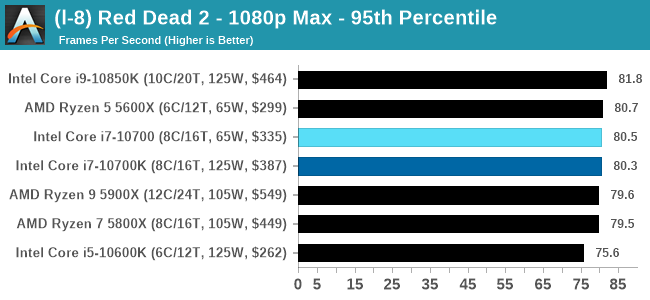 |
All of our benchmark results can also be found in our benchmark engine, Bench.












210 Comments
View All Comments
quiq - Sunday, January 24, 2021 - link
I would have liked them to test the processors in addition to the heatsink that comes in the retail box, that would provide a sample of how the product behaves that an end user obtains when buying it. Obviously the use of a heatsink from a 3rd party manufacturer improves the performance of both due to the superior ability to eliminate heat, which helps to maintain the turbo frequencies for longer in both processors.olde94 - Monday, January 25, 2021 - link
one thing i don't see is that the CPU is officially rated 2.9ghz. Not 4.0 as the graphs seems to suggest. We are getting 4.0 with propper cooling, but what i gave it a 90W cooler? Would i end up back at 2.9ghz? We all know that frequency and powerdraw is never a linear curve so we might see 25% lower powerformance at 1/3 the power draw and as such their claim about 65w could be true, but that it peaks if allowed to. I mean don't get me wrong, it's shitty, but is it really that wrong though?noxplague - Monday, January 25, 2021 - link
Dr. Cuttess, thank you as always for these in-depth analyses.I would really like to see how this compares with the previous 9th generation Intel parts (9900, 9700, 9600, etc). However in your bench tool the 2020 and 2019 tests make this difficult. Couldn’t the data be back ported or forward ported and just put N\A for tests that aren’t in both datasets?
I love then bench tool, but it’s recently hamstrung by not allowing for comparisons of 8th gen and 9th gen (and equivalent AMD parts)
Nesteros - Wednesday, January 27, 2021 - link
I was under the impression that TDP was the maximum amount of thermal energy, measured in watts, that a CPU would ever produce and would need to be “removed” by the thermal solution, not the amount of energy measured in watts that a CPU consumes. Surely a processor is not converting all of the power it consumes into heat, else it would be a very efficient space heater and not a CPU.Qasar - Thursday, January 28, 2021 - link
take a look at this :https://www.anandtech.com/show/13544/why-intel-pro...
simply put, intel bases its TDP at BASE clocks, with what they would consider default settings. AMD, bases its TDP, on, for the most part, max power draw. same value, WAY different view of what TDP is between them
Peter-fra - Saturday, February 13, 2021 - link
Dear Anandtech team, thanks a lot for this great clarification of the difference between K and non K Intel products. However, I would like to know what you think about these Geekbench multi-score results showing a gap of around 13% between the 10700 and 10700k on multi-core bench ?=> https://browser.geekbench.com/processor-benchmarks
Since the difference of all core turbo frequency between those 2 processor is around 2-3% (4.7Ghz vs 4.6Ghz) I cannot understand why there would be a 13% gap on this benchmark ?
Does it mean that the Geekbench aggregated data of the 10700 comes from OEM builds with entry level motherboard which doesn't maximize turbo (probably because the VRM are not great) and stay within the intel recommended turbo ?
Scour - Monday, February 15, 2021 - link
That´s the end of my 350W-PSUs :(stealth-katana - Friday, April 2, 2021 - link
The image with the text written with a sharpie on the CPU is making me cringe. 🤣briantim - Wednesday, September 8, 2021 - link
http://home.anandtech.com/show/16343/intel-core-i7...